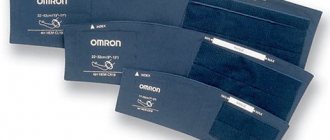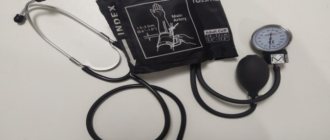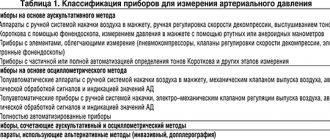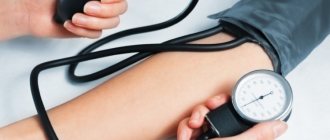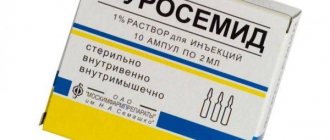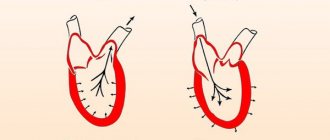At the initial appointment with a specialist, the patient is given the first measurement of arterial parameters, using a mechanical, semi-automatic or automatic device for measuring blood pressure - a tonometer.
Considering that restoration of intravascular tension can take years, the patient will need to purchase his own blood pressure measuring device in order to determine the cause of poor health in time and take medications.
A tonometer is a modern medical device used for non-invasive measurement of blood pressure (the device causes pain and does not violate the integrity of the skin during examination).
Thanks to this equipment, you can control blood pressure painlessly, quickly and without the help of medical personnel, and avoid complications that can lead to hypotension or hypertension.
Devices for measuring blood pressure non-invasively are divided into several types, this greatly simplifies their operation. Today, semi-automatic and automatic blood pressure monitoring devices are in demand, but the mechanical one is also not inferior to its improved counterpart. Let's consider all the features and advantages of pressure measuring devices: which one is better? It is important to decide how to choose a device that performs high-performance blood pressure measurement.
A little about pressure
Blood pressure levels are expressed as two numbers, written as a fraction. The numbers mean the following: at the top is systolic pressure, which is popularly called upper, at the bottom is diastolic, or lower. Systolic is recorded when the heart contracts and pushes out blood, diastolic - when it relaxes to its maximum. The unit of measurement is millimeter of mercury. The optimal blood pressure level for adults is 120/80 mmHg. pillar Blood pressure is considered elevated if it is more than 139/89 mmHg. pillar
A condition in which its level remains consistently high is called hypertension, and a stable decrease is called hypotension. The difference between the upper and lower should be 40-50 mmHg. Blood pressure changes throughout the day for all people, but in hypertensive patients these fluctuations are much sharper.
How to choose the right tonometer
Details you need to pay attention to when purchasing a tonometer:
- It is very important to choose the correct cuff size. Ask your doctor, nurse, or pharmacist what size cuff you need based on your arm size. Your blood pressure readings may be incorrect if your cuff size does not match your arm size.
- The numbers (measurement results) should be easy to read on the display. You should be able to see them clearly.
- If you are using a stethoscope, you should be able to hear sounds through it.
- Price is also an important factor. Since now the prices of different models of tonometers vary greatly, you have the opportunity to take a closer look at their prices and quality, and, by comparing all this, make the right choice. The most expensive models and the accuracy of their measurements may not be better than cheaper ones.
How can I make sure that my blood pressure monitor is accurate and that I am using it correctly?
Once you buy a blood pressure monitor, take it to your doctor to check how accurate the measurements are. You should check your blood pressure monitor once a year. Careful use and storage are also necessary. Make sure that the screw valve on the bulb is closed at the time of purchase, and keep it (the bulb) away from fire and hot objects. Check the pear periodically for cracks and holes.
Ask your doctor or nurse to teach you how to use the blood pressure monitor correctly. Using a blood pressure monitor correctly will help you and your doctor achieve good results and monitor your blood pressure regularly.
Understanding medical terms.
- Blood pressure is the force with which blood presses on blood vessels.
- Hypertension is an increase in maximum blood pressure above 130 mmHg. Art.
- The brachial artery is a blood vessel that runs from the shoulder to the elbow. You measure the blood pressure in this artery.
- Systolic pressure is the maximum pressure observed during systole, the moment when blood from the heart is ejected into the aorta.
- Diastolic pressure is the minimum pressure observed during diastole, when the heart “rests”.
- Normal values exist for both systolic and diastolic pressures. Normal blood pressure is 120/80, where the first number is the systolic pressure and the second is the diastolic pressure.
Why do you need to know your blood pressure?
Even a slight increase in blood pressure increases the risk of heart attack, stroke, ischemia, heart and kidney failure. And the higher it is, the greater the risk. Very often, hypertension in the initial stage occurs without symptoms, and a person is not even aware of his condition.
Measuring blood pressure is the first thing to do if you complain of frequent headaches, dizziness, or weakness.
Hypertensive patients should measure their blood pressure every day and monitor its level after taking the pills. People with high blood pressure should not sharply reduce it with medications.
Which tonometer is better
The most suitable option for home use is an automatic shoulder tonometer.
It is quite accurate in measurements and does not require special skills for independent use. Modern models have a built-in memory function for one, two or three users with up to 150 measurements for each. You can save and compare measurement results, which replaces a self-monitoring diary. Any automatic tonometer is equipped with a visual indicator of the elbow crease. This allows the cuff sensor to be placed exactly where the artery pulsation is strongest. Air injection occurs automatically, according to a specific program, ensuring the pressure inside the cuff of the required force.
This is very important for older people suffering from hypertension. In some cases, such patients experience auscultatory gaps: zones of silence that are clearly distinguishable by auscultation of heart sounds.
If a mechanical tonometer is used by a person who is not aware of the possibility of such a pathology, he may miss the moment when the tones disappear (for example, at 110 with a real pressure of 200) and stop pumping air above 120–135 mmHg. This leads to false-normal readings at really high blood pressure.
Electronic tonometers have the function of additional air injection into the cuff and double control, which is very helpful in case of atrial fibrillation or auscultatory failure. Almost guarantees accurate detection of hypertensive crisis.
Methods for measuring blood pressure
Blood pressure levels can be determined directly and indirectly.
Straight
This invasive method is highly accurate, but it is traumatic because it involves directly inserting a needle into a vessel or cavity of the heart. The needle is connected to the pressure gauge by a tube containing an anti-clotting agent. The result is a curve of blood pressure fluctuations recorded by a scribe. This method is most often used in cardiac surgery.
Indirect methods
Typically, pressure is measured in the peripheral vessels of the upper extremities, namely in the elbow bend of the arm.
Nowadays, two non-invasive methods are widely used: auscultatory and oscillometric.
The first (auscultatory), proposed by the Russian surgeon N. S. Korotkov at the beginning of the 20th century, is based on clamping the shoulder artery with a cuff and listening to the tones that appear when air is slowly released from the cuff. Upper and lower pressure are determined by the appearance and disappearance of sounds that are characteristic of turbulent blood flow. Blood pressure measurement using this method is carried out using a very simple device consisting of a pressure gauge, a phonendoscope and a cuff with a pear-shaped balloon.
When measuring blood pressure in this way, a cuff is placed on the shoulder area, into which air is pumped until the pressure in it exceeds systolic pressure. At this moment, the artery is completely pinched, the blood flow in it stops, and no sounds are heard. As the cuff begins to deflate, the pressure decreases. When the external pressure is compared with the systolic pressure, blood begins to pass through the compressed area, noises appear that accompany the turbulent flow of blood. These are called Korotkoff sounds and can be heard with a phonendoscope. At the moment when they occur, the value on the pressure gauge is equal to systolic blood pressure. When the external pressure is compared with the arterial pressure, the sounds disappear, and at this moment the diastolic pressure is determined using the manometer.
To measure Korotkoff blood pressure, a mechanical tonometer is used.
The microphone of the measuring device picks up Korotkoff sounds and converts them into electrical signals, which are sent to a recording device, on the display of which the values of the upper and lower blood pressure appear. There are other devices in which the arising and disappearing characteristic noises are determined using ultrasound.
The Korotkoff blood pressure measurement method is officially considered a standard. It has both pros and cons. Among the advantages include high resistance to hand movement. There are several more disadvantages:
- Sensitive to noise in the room where measurements are taken.
- The accuracy of the result depends on whether the head of the phonendoscope is correctly positioned and on the individual qualities of the person measuring blood pressure (hearing, vision, hands).
- Skin contact with the cuff and microphone head is required.
- It is technically complex, which causes errors in measurements.
- This requires special preparation.
Oscillometric With this method, blood pressure is measured with an electronic tonometer. The principle of this method is that the device registers pulsations in the cuff, which appear when blood passes through a compressed area of the vessel. The main disadvantage of this method is that the hand must be motionless when measuring. There are quite a lot of advantages:
- No special training is required.
- The individual qualities of the person measuring (vision, hands, hearing) do not matter.
- Resistant to noise present in the room.
- Determines blood pressure with weak Korotkoff sounds.
- The cuff can be worn over a thin jacket, and this does not affect the accuracy of the result.
What equipment do I need to measure my blood pressure?
To measure blood pressure at home, you can use dial and digital tonometers. A dial tonometer has a scale with divisions, as well as an arrow, with the help of which the pressure is determined. There is a cuff and a pressure bulb. The cuff is placed on the surface of the shoulder and a pressure above the expected systolic pressure is created in it using a rubber pressure bulb. The tightness of the cuff is assessed as follows: a finger should pass between the cuff and the surface of the shoulder. A digital tonometer can have either a manual or an automatic bulb. The measurement results of such a tonometer are displayed on a small screen. Choose which type of blood pressure monitor best suits your needs.
What are the pros and cons of a dial tonometer?
One of the advantages of such a tonometer is that it can be easily moved from one place to another. In addition, a stethoscope is already built into the cuff, which means you do not have to additionally purchase a separate stethoscope. The dial tonometer does not require very careful treatment. He may also have a special device with which you can put the cuff on your arm even with one hand. And on top of that, a dial tonometer is cheaper than a digital one.
But the dial tonometer also has some disadvantages. First, it is a complex device that can easily break, resulting in inaccurate measurements. This device is quite difficult to use unless it has a special device - a metal ring - that makes it easier to put on the cuff. The rubber bulb used to apply pressure to the cuff may be difficult to inflate. In addition, such a tonometer is not suitable for people with impaired hearing, since when using it it is necessary to listen to sounds through a stethoscope.
What are the pros and cons of a digital blood pressure monitor?
A digital blood pressure monitor is automatic, which is why it is a more popular device for measuring blood pressure. The measurement results are easy to read as they are displayed on the screen. Some electronic tonometers have a built-in printer with which you can print the results of the measurements.
A digital tonometer is easier to use than a dial one. With such a tonometer, the stethoscope and the measuring device itself are connected into a single device, and the measurement results are easy to read. There is also an indicator indicating an error. After the measurement, the air is automatically released from the cuff. The cuff can be inflated either automatically or manually, depending on the model. This tonometer is suitable for people who are hard of hearing, since when using it there is no need to listen to sounds through a stethoscope.
The disadvantage of a digital tonometer is that the accuracy of the measurements varies with different body movements and arrhythmias. In addition, this tonometer requires batteries. Some models are made in such a way that they can be used to measure pressure exclusively on the left hand. This makes them difficult to use for some people. In addition, digital blood pressure monitors are expensive.
Can I use a finger/wrist monitor?
Studies have shown that finger/wrist blood pressure monitors measure blood pressure very inaccurately. They are very sensitive to posture and body temperature, and, in addition, they are much more expensive than other types of tonometers.
Types of tonometers
Today, aneroid (or mechanical) devices and electronic ones are used to determine blood pressure.
The former are used to measure pressure using the Korotkoff method in a medical facility, since they are too complex for home use, and untrained users receive results with errors when taking measurements.
An electronic device can be automatic or semi-automatic. Such tonometers are intended for daily home use.
Anyone can use an electronic tonometer to measure their own blood pressure and pulse.
When is daily blood pressure monitoring prescribed?
How does blood pressure behave during the day? This question is answered by daily blood pressure monitoring.
We talked about this research method with our regular consultant, general practitioner, cardiologist at Clinic Expert Voronezh, Kalinina Angelina Anatolyevna.
— Angelina Anatolyevna, what is daily blood pressure monitoring?
Daily blood pressure monitoring is a method of functional diagnostics. Its essence is repeated measurement of blood pressure throughout the day or more using a special device.
— What information about the patient’s health can daily blood pressure monitoring give the doctor? Tell us about the indications for prescribing ABPM
This research method is quite informative, and you can rely on it when diagnosing arterial hypertension. The purpose of the study is to determine a more accurate level of pressure and/or control the degree of its reduction during treatment.
Read the material on the topic: What are the reasons for high blood pressure?
This method also allows you to determine the average pressure values during the day, night, day (which, for example, is important when it is variable), the ratio of night and day pressure as a factor that allows you to assess the risk of cardiovascular outcomes.
Indications for ABPM are:
— “white coat hypertension” (pressure is within the normal range at home, but in a medical facility during repeated visits it turns out to be elevated);
— “masked” hypertension (when blood pressure is normal at a doctor’s appointment, but increases when measured at home or anywhere else);
— significant pressure fluctuations;
— various types of hypotension (low blood pressure);
- in pregnant women, including those with suspected preeclampsia;
— significant discrepancies between blood pressure readings at the doctor’s appointment and at home;
- suspicion of hypertension at night or lack of pressure reduction during this period of the day;
— assessment of the effectiveness of the therapy.
— Are there any contraindications to daily blood pressure monitoring?
There are no absolute contraindications for the examination. With ABPM, there are rather limitations in terms of placement of the device. For example, some kind of skin pathology in the area where the cuff is installed. Due to possible allergic reactions in some people, it is recommended to apply it on a thin cotton cloth.
Read the material on the topic: When there is nowhere lower. Understanding the causes of hypotension
An obstacle to applying a cuff may be a fracture, bruise, burn or its consequences. In this case, a healthy arm is selected, or the study is carried out after recovery.
— What is a 24-hour blood pressure monitoring device and how is the ABPM procedure performed?
The device consists of a cuff (like a conventional tonometer), a device for recording the data obtained, and tubes connecting the device to the cuff.
The device is in a case secured with a belt on the patient's shoulder or belt.
ABPM IS A VERY ACCURATE AND INFORMATIVE METHOD, THEREFORE IT IS APPROPRIATE TO USE IT IN THE PROCESS OF DIAGNOSIS OF HYPERTENSION
On the appointed day, the person comes for examination. A cuff is put on his arm, the device is secured, and the person leaves.
Over the next 24 hours, the device automatically measures the person’s blood pressure at intervals specified by the program. During the day, measurements are taken every 20-30 minutes, at night - every hour.
Before starting the measurement, the device warns about this with a sound signal. In this case, the person ideally needs to stop, straighten and relax his arm, and keep it in this position until the end of the full measurement cycle (i.e., pumping and deflating air). Do not move your hand during measurement. If the device “does not like” the measurement conditions (for example, the arm is bent and/or tense), it will try to make a new measurement.
Read the material on the topic: Holter (24-hour) ECG monitoring - complete instructions for the patient
The next day the person comes to the doctor who installed the device. The latter is removed, and the resulting data is decrypted and interpreted. On their basis, a conclusion is issued.
— How does ABPM differ from independent daily blood pressure measurement at certain hours? Why is keeping a blood pressure diary not enough?
Firstly, this is a more objective method, i.e. subjectivity, the level of technical proficiency of the person measuring, and possibly not entirely correct operation of the home apparatus are excluded.
Secondly, a large number of measurements are performed during ABPM. From a purely organizational point of view, it will be very inconvenient for a person to do this.
Thirdly, measurement conditions: it is easier to obtain information using the device.
ABPM is a fairly accurate and informative method, therefore, in my opinion, it is advisable to use it in the process of diagnosing hypertension.
— Daily blood pressure monitoring requires special training?
No.
— How reliable are the results obtained during the examination?
The reliability of the results obtained with ABPM is quite high - of course, subject to the conditions of the procedure. This, of course, is the serviceability of the device, its correct operation and wearing.
— How long after 24-hour blood pressure monitoring is the report ready?
Usually within an hour.
— What can affect the reliability of the conclusions obtained during daily blood pressure monitoring?
This is, of course, the patient’s behavior: failure to follow instructions, excessive hand movements, etc.; contact with water, high humidity, temperature above +50°C.
— How should a patient behave during the study? What can and cannot be done during 24-hour blood pressure monitoring?
Avoid rooms with high humidity (bath, sauna); normal hygiene procedures are possible, but contact of the device with water or steam must be completely excluded.
During the period of diagnosis of ABPM, it is necessary to wear cotton clothing (not synthetic or woolen).
While sleeping, carefully place the device next to you, trying not to squeeze the tubes.
Avoid active physical activity and movements involving the hands.
When measuring pressure, stop, straighten your arms and wait until the measurement is completed.
Keep a diary - the more detailed, the better. Periods of sleep and wakefulness, times of eating (you can additionally note the consumption of caffeine-containing drinks) and medications, activities performed (including climbing stairs, moving indoors and outdoors), emotional experiences, and stressful situations are noted.
Read the material on the topic: Vegetative-vascular dystonia: diagnosis or fiction?
If a person does not feel very well, and the measurement was taken recently, you can manually make an extraordinary measurement by pressing a special button (check this point separately with the doctor and/or nurse who will install the device on you).
If the cuff is twisted or has slipped, you should try to fix it yourself, and if unsuccessful, call the doctor conducting the study or another contact person.
You should not stay near sources of electromagnetic radiation for a long time.
— Angelina Anatolyevna, ABPM is an independent examination that allows you to identify the causes of hypertension or hypotension, or is it not enough to undergo only this one type of diagnosis in case of pressure changes?
This is a very informative method that allows you to identify high or low blood pressure as a syndrome, but to establish a diagnosis in each specific case, mandatory and, if indicated, additional studies are performed - laboratory and instrumental.
You can find out the cost of daily blood pressure monitoring by calling the phone number listed on the contacts tab
Please note: the service is not available in all cities
— In order to undergo examination in your clinic, do you need a doctor’s prescription?
Not necessary. You can be examined without a referral.
You may also be interested in:
Coronary heart disease: diagnosis and treatment
Serious question: what happens to the heart during an angina attack?
Why is electroencephalography needed?
For reference:
Kalinina Angelina Anatolevna
In 2007 she graduated from the Voronezh State Medical Academy named after. Burdenko.
From 2007 to 2008 she completed an internship in therapy, in 2010 she underwent professional retraining in the specialty “General Medical Practice (Family Medicine)”, and in 2017 – in the specialty “Cardiology”.
From 2015 to the present, he has held the position of general practitioner at Clinic Expert Voronezh, and since 2021, he has been a cardiologist. Reception is conducted at the address: st. Pushkinskaya, 11.
General rules for measuring blood pressure
Blood pressure is most often measured while sitting, but is sometimes done while standing or lying down.
People's daily blood pressure is constantly changing. It increases with emotional and physical stress. It can be measured not only in a calm state, but also during physical activity, as well as in breaks between different types of loads.
Since blood pressure depends on a person's condition, it is important to provide the patient with a comfortable environment. The patient himself needs to not eat, not engage in physical labor, not smoke, not drink alcoholic beverages, and not be exposed to cold for half an hour before the procedure.
During the procedure, you should not make sudden movements or talk.
It is recommended to take measurements more than once. If a series of measurements is made, between each approach you need a break of about one minute (at least 15 seconds) and a change of position. During the break, it is recommended to loosen the cuff.
The pressure on different hands can vary significantly; therefore, measurements are best taken on the one where the level is usually higher.
There are patients whose blood pressure is always higher in the clinic than when measured at home. This is explained by the excitement that many feel when they see medical workers in white coats. For some, this can happen at home as well, as a reaction to measurement. In such cases, it is recommended to take measurements three times and calculate the average value.
Table of norm indicators
Each person, depending on many factors, develops his own working pressure, it is individual. The upper limit of normal is 135/85 mmHg. Art. The lower limit is 95/55 mm Hg. Art.
Blood pressure greatly depends on age, gender, height, weight, and the presence of diseases.
| Systolic pressure, mm Hg. Art. | Diastolic pressure, mm Hg. Art. | Age |
| 60–95 | 40–60 | up to 2 weeks |
| 85–115 | 55–70 | up to 3 years |
| 100–120 | 60–80 | 4–9 years |
| 110–130 | 65–80 | 10–15 years |
| 100–130 | 65–80 | 16–20 years old |
| 120–135 | 70–85 | 21–40 years old |
| 125–140 | 75–90 | 41–59 years old |
| 130–140 | 80–90 | over 60 years old |
The procedure for determining blood pressure in different categories of patients
In the elderly
This category of people often experiences unstable blood pressure, which is associated with disturbances in the blood flow regulation system, decreased vascular elasticity, and atherosclerosis. Therefore, elderly patients need to take a series of measurements and calculate the average value.
In addition, they need to measure their blood pressure while standing and sitting, since they often experience a sharp drop in blood pressure when changing positions, for example, when getting out of bed and sitting.
In children
It is recommended that children measure blood pressure with a mechanical tonometer or an electronic semi-automatic device, and use a children's cuff. Before measuring your child’s blood pressure yourself, you need to consult with your pediatrician about the amount of air pumped into the cuff and the measurement time.
In pregnant women
Blood pressure can tell you how well your pregnancy is going. For expectant mothers, it is very important to constantly monitor blood pressure in order to start treatment on time and avoid serious complications in the fetus.
During pregnancy, blood pressure monitoring is mandatory
Pregnant women need to measure their blood pressure while reclining. If its level exceeds the norm or, conversely, is much lower, you should immediately consult your doctor.
For cardiac arrhythmia
People who have irregular heartbeat sequence, rhythm and frequency should measure their blood pressure several times in a row, discard clearly incorrect results and calculate the average value. In this case, the air from the cuff must be released at a lower speed. The fact is that with cardiac arrhythmia, its level can vary significantly from beat to beat.
Blood pressure measurement algorithm
Blood pressure measurements should be taken in the following order:
- The patient is seated comfortably on a chair so that his back is adjacent to the back, that is, has support.
- The hand is freed from clothing and placed on the table with the palm up, placing a roll of a towel or the patient’s fist under the elbow.
- A blood pressure cuff is placed on the bare shoulder (two to three centimeters above the elbow, approximately at heart level). Two fingers should fit between the hand and the cuff, its tubes pointing down.
- The tonometer is at eye level, its needle is at the zero mark.
- Find the pulse in the ulnar fossa and apply a phonendoscope to this place with slight pressure.
- The valve on the tonometer bulb is screwed on.
- The pear-shaped balloon is compressed and air is pumped into the cuff until pulsation in the artery can no longer be heard. This occurs when the pressure in the cuff exceeds 20-30 mmHg. pillar
- Open the valve and release air from the cuff at a speed of about 3 mmHg. pillar, while listening to Korotkoff sounds.
- When the first constant tones appear, record the pressure gauge readings - this is the upper pressure.
- Continue to release air. As soon as the weakening Korotkoff sounds disappear, the pressure gauge readings are recorded - this is the lower pressure.
- Release air from the cuff, listening to sounds, until the pressure in it becomes equal to 0.
- Allow the patient to rest for about two minutes and measure blood pressure again.
- Then remove the cuff and record the results in a diary.
Correct position of the patient during blood pressure measurement
Step-by-step instruction
How to measure blood pressure correctly with a mechanical tonometer:
- Take a sitting position (a sofa or armchair is suitable for this).
- Lean your back on the back of the chair, and place your feet on the floor (it is not recommended to cross them, tuck them in, throw them on top of each other, etc.).
- The left hand is freed from clothing and placed on a table or any other flat surface. The main thing is that it is not in a canopy.
- Open the cuff, insert your hand into it and secure it slightly above (2-3 cm) the elbow bend.
- Place part of the stethoscope in the form of a small metal disk on the inside of your elbow. It is important that the pulsating artery is clearly felt in this place.
- If you are performing this procedure for the first time and do not yet fully understand how to correctly measure pressure with a mechanical tonometer, then first feel the pulse with your fingers. For the future, you will know exactly where to place the metal part of the stethoscope.
- Then insert the hearing aid stethoscope into your ears.
- Make sure the air release wheel on the bulb is tightly closed.
- Place the rubber bulb of the tonometer in your hand and begin manually supplying air. The arrow on the dial will begin to move. After it reaches the 200-220 mm mark. rt. Art., stop squeezing the bulb and slowly begin to spin the wheel. The air should come out slowly, about 4 mmHg. Art. per second.
- As the air descends, you should hear a pulse. The number where the needle will be on the first beat is your systolic pressure (i.e., top). The pulse will be heard for some time. The value at which the needle will be at the last beat is your diastolic blood pressure (i.e., lower).
- Measure blood pressure on the other arm. Consider higher values as reliable. In the future, measure the pressure on the arm where it is higher.
- Both results obtained must be written down or remembered.
In general, this process will take you a few minutes. This procedure must be carried out daily, recording the data obtained. Thus, you can determine the average values of your upper and lower pressure.
Wrist blood pressure measurement technique
To measure blood pressure at the wrist with an electronic device with a cuff, you must follow the following instructions:
- Remove watches or bracelets from your wrist, unbutton the sleeve and fold it back.
- Place the tonometer cuff 1 centimeter above the hand with the display facing up.
- Place the hand with the cuff on the opposite shoulder, palm down.
- With your other hand, press the “Start” button and place it under the elbow of your cuffed arm.
- Remain in this position until the air is automatically released from the cuff.
This method is not suitable for everyone. It is not recommended for people with diabetes, atherosclerosis and other blood supply disorders and changes in the vascular walls. Before using such a device, you need to measure the pressure with a tonometer with a cuff on the shoulder, then with a cuff on the wrist, compare the obtained values and make sure that the difference is small.
A wrist blood pressure monitor has both advantages and disadvantages.
What to consider when measuring pressure
- Stress can significantly change the readings, so you need to measure it in a calm state.
- Blood pressure increases with constipation, immediately after eating, after smoking and drinking alcohol, with excitement, and in a sleepy state.
- It is best to carry out the procedure one to two hours after eating.
- Blood pressure should be measured immediately after urination, since it is elevated before urination.
- The pressure changes when taking a shower or bath.
- A nearby mobile phone can change the tonometer readings.
- Tea and coffee can change blood pressure.
- To stabilize it, you need to take five deep breaths.
- It increases when you are in a cold room.


